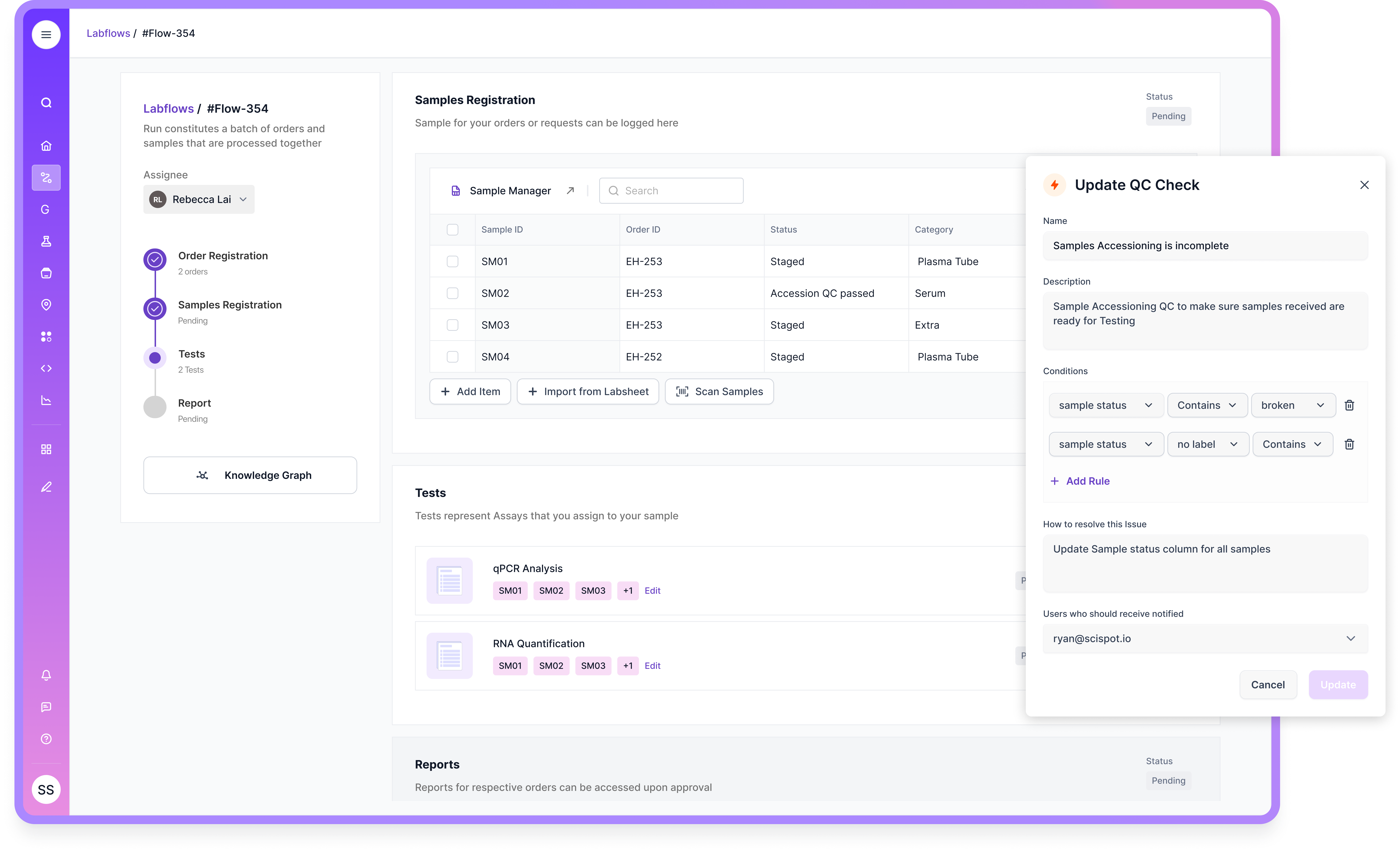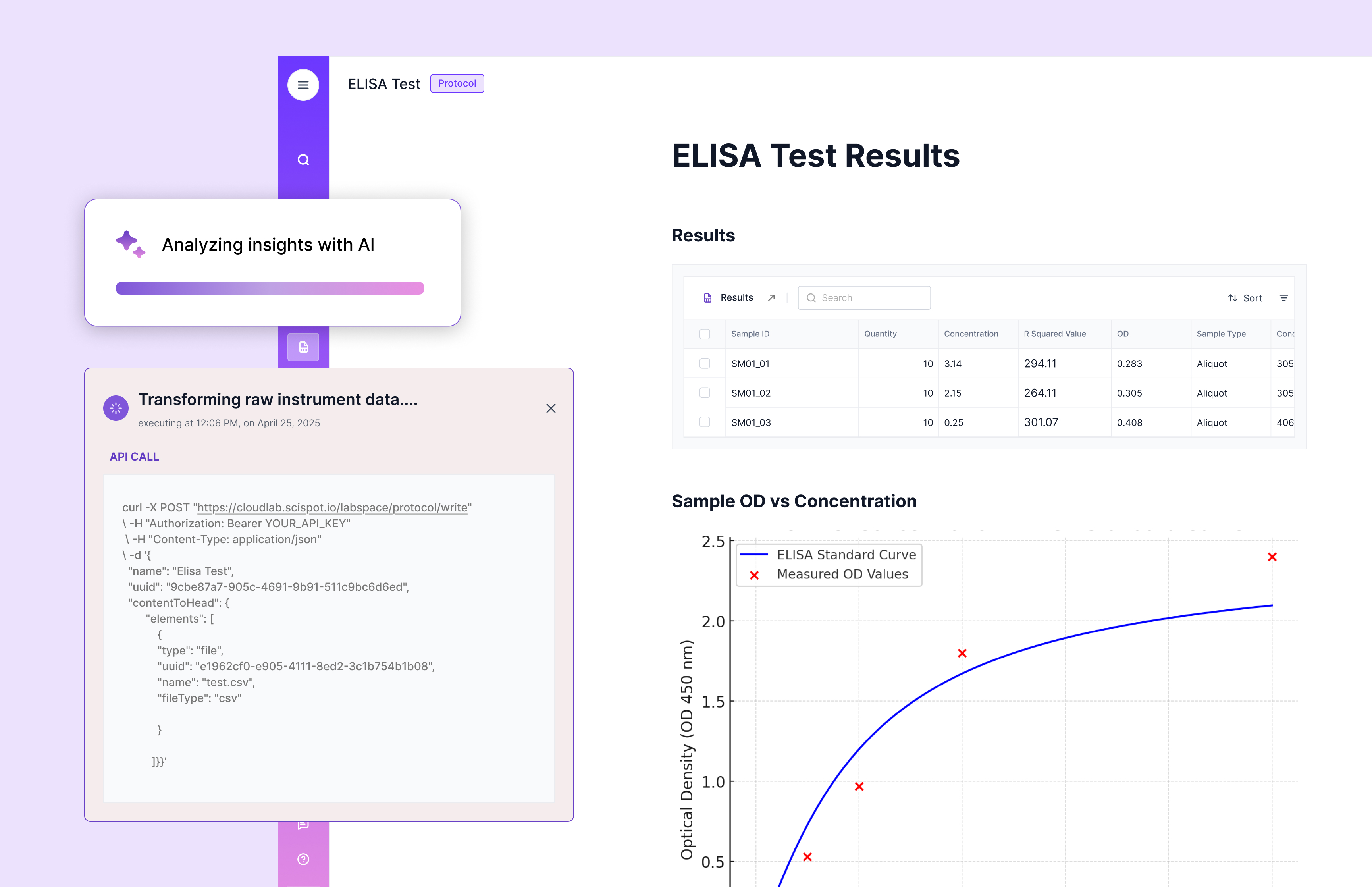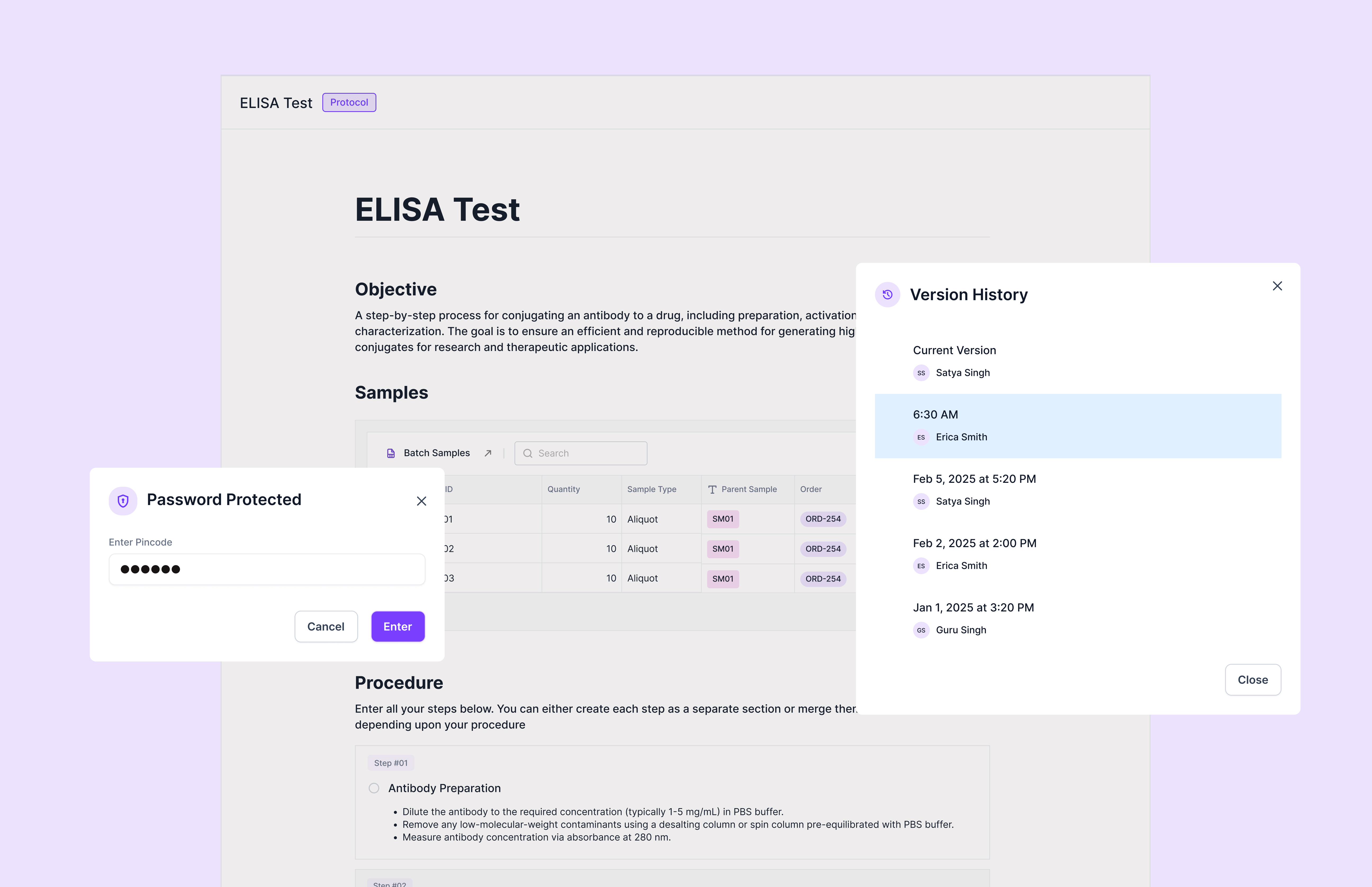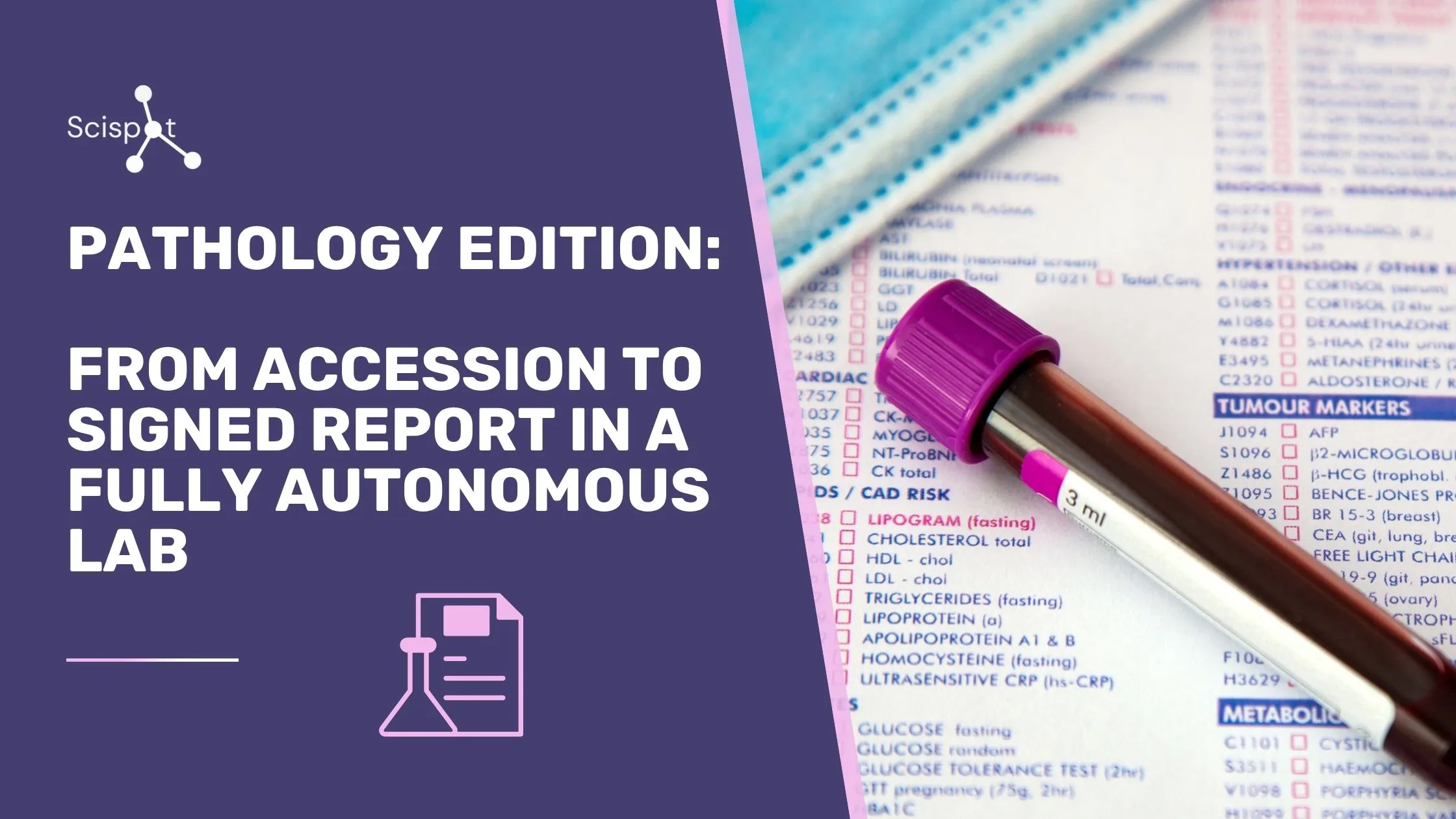Pathology is where every detail matters. Slides move. Blocks fragment. Images and results arrive from many places. Audits demand a clear story. Scispot turns this motion into a single flow—from order intake to final signature—without spreadsheets, retyping, or guesswork.
Scispot feels like a lab operating system. Scispot's Labspaces keep SOPs and protocols versioned and reviewable. Other Scispot apps, like Labsheets, hold structured data with links to samples, slides, images, and results. And Labflows guides sample-centric workflows, each case step by step, with gates for QC and e‑signatures. A knowledge graph binds the pieces so the full chain of custody is always one click away.

Context: what pathology teams fight every day
Manual tracking steals time and creates risk. Slide IDs get typed by hand. Images land in folders with no context. Reports take too long to assemble. Leaders want turnaround time, but timestamps live in email. Inventory and calibration live elsewhere. Teams need one place that is traceable, compliant, and fast.
End‑to‑end traceability and compliance
Scispot records every action with who, what, when, and where. The chain of custody follows a sample from receiving to grossing, embedding, cutting, staining, scanning, review, and report. Clinical controls—like 21 CFR Part 11 e‑signatures, audit logs, and role‑based access—come built in. CLIA, CAP, ISO 15189, GDPR, and HIPAA needs are supported, with BAAs when required. You can show an inspector the exact path a case took in seconds instead of searching across folders.
From half‑hour reports to one‑click PDFs
Reporting should be a pull, not a rebuild. Because Scispot captures every data point along the way, the final report appears with one click. Case data, controls, QC flags, images or links, reviewer notes, and signatures are composed into the right template. You can release as a PDF, deliver by API, or publish to a portal. Teams move from manual assembly to review and sign‑off in minutes.

Turnaround time and accountability without micromanaging
Labflows logs every step with precise timestamps. Dashboards show where each case sits, how long it stayed there, and what is late. You can ask in plain language for today’s TAT, bottlenecks by station, or cases blocked by QC. Assignments notify people by email or in‑app. Managers get signal, not noise, and techs see only what they need to do next.
Barcode‑first identity and error‑proof intake
Scispot generates unique IDs for every sample, block, slide, and data row. Barcode printing and scanning happen inside the flow. Even if a label is mis‑typed in the wild, the platform’s system IDs and lineage keep the case traceable. Container hopping—cassette to slide to image—is tracked automatically, so mislabels stop being mysteries.
Equipment, reagents, and readiness
Protocols link to exact instruments and lots. Calibration dates, certificates, and status are visible inside the SOP. Reagent expiry and lot usage are enforced at the bench. When a tech scans a reagent, the system records consumption and decrements inventory. If stock will run out mid‑run, Scispot warns early. Reorder lists and purchase packets generate from live usage, so your day doesn’t start with a scavenger hunt.
IHC and imaging with context that never breaks
IHC is more than a stain; it is metadata. Scispot captures panel, antibody lot, dilution, incubation, control status, and the micro‑actions that matter. Whole slide images link back to the originating slide and block, with viewer links stored as first‑class fields. QC rules catch gaps, like missing controls or out‑of‑date lots, before review. If a result needs a rerun, the flow branches and keeps the full story intact.

Cell culture and passaging, without losing lineage
Some pathology labs run cell work alongside tissue. Scispot treats each passage as a first‑class event. Counts, viability, and instrument outputs land in the same table as lineage. Parent–child links keep the culture family tree visible. When a line feeds an assay, the exact passage and conditions travel with it to the final report.
Partner data, PDFs, and flat files without retyping
External results arrive in many shapes. Scispot ingests common files and parses vendor PDFs with tuned extractors. Values map into your data model with a human in the loop for final checks. The original document remains linked for audit. People get notified the moment results land, and cases move forward without manual copy‑paste.
Patient and clinician portals that match your voice
Order intake can live in a branded portal with your language and fields. Dropdowns capture common codes and reduce free‑text errors. Barcodes print on demand. Results can return to the portal or be pushed to external systems by API. HL7 or FHIR integration ties into existing clinical environments so you avoid double entry.
Scale without breaking the day
Workloads spike. New services launch. Scispot scales with you. High throughput is normal, not special. Watchers see new instrument files and run transformations. Auto‑scaling keeps performance steady. Timestamps and TAT stay trustworthy, even when volume jumps.
.jpeg)
Security, privacy, and residency
Data is encrypted in transit and at rest. Access is role‑based and fully audited. Backups run on a tight cadence. Residency options keep data in the region you require. You own your data and can export in bulk at any time. A second copy can live in your cloud by default.
Deployment speed and white‑glove help
Rollouts land in weeks, not quarters. A dedicated team helps design your data model, map your SOPs, build flows, and connect instruments. If you need deeper help, forward‑deployed engineers handle scripting and integration while you keep ownership. Small teams get the same care as large ones, and configurations remain yours.
Implementation corner: a fast path for pathology
Month one focuses on a clean accessioning model, a stain panel with QC gates, barcode flows, and one signed report template. A viewer link pattern is set, and one instrument feed goes live. Month two expands to multi‑panel IHC, inventory, and expiry enforcement, and a clinician portal. Dashboards for TAT and bottlenecks become routine. Month three locks validation steps, turns on automated deliveries by API, and opens an external data lane for PDFs and flat files. By then, the team is spending time on cases, not copy‑paste.
Decision desk: direct answers to common questions
Can we enforce “no skip” QC and still move fast? Yes. Gates block unsafe steps while green paths stay one‑click. Deviations are logged with rationale and signatures.
Can we run de‑identified flows? Yes. The system supports de‑ID and still preserves a chain of custody for audit.
Do we need a separate QMS? Many teams run with Scispot’s built‑in controls. If you use a dedicated EQMS, Scispot integrates and shares training status, sign‑offs, and events.
What if we already have inventory and ordering elsewhere? Scispot integrates cleanly. You can keep the external system and still see live consumption inside the case.
How do we handle mistakes? Every action is versioned. Authorized users can revert and annotate. The audit trail remains intact.

A day in the life
Accessioning starts in the morning. Orders arrive through the portal and by API. Labels print. Slides scan into the flow. The system assigns the right stain panel and due date. Controls and lots are checked before a single rack enters the stainer.
An instrument drops a run file. A watcher ingests it, runs a transformation, and tags out‑of‑range values. A reviewer approves with one click. The case moves forward. A missing control blocks one sample and opens a rework loop. The tech prints a new label, reruns, and clears the gate.
A whole slide image uploads and links to its slide and block. The reviewer opens the viewer from the case page, adds notes, and signs. The report composes with context and signatures and is delivered both as a PDF and by API to the receiving system. Inventory alerts generate a reorder packet with vendor details and SKUs. Backups complete, and a second copy lands in the lab’s own cloud.
How this advances the self‑driving lab
Self‑driving is rails plus judgment. Scispot lays the rails with Lab Flows, knowledge graphs, ELT, and QC gates. Humans make the calls that matter and sign when it counts. As more steps run reliably, more of the case becomes “hands‑free.” Intake, routing, parsing, QC checks, report composition, notifications, and reorders all run on their own. What remains is expert review, mentoring, and science. That is practical autonomy—trustworthy, explainable, and ready for audits.
Final word
Pathology needs precision at speed. Scispot gives both. It replaces scattered tools with a calm, connected system. It keeps your team in one place, keeps data clean, and keeps inspectors satisfied. The result is less rework, fewer delays, and a clear path from accession to signature.
Next week
We will go deeper into interoperability and other core Scispot specialties that enable the vision of a self-driving lab.
.gif)





.webp)
.webp)
.webp)



